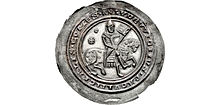Ludwig III. (Thuringia)

Ludwig III. , called the Pious or the Mild , (* 1151/1152; † October 16, 1190 Eastern Mediterranean near Cyprus ) from the Ludowinger family was Landgrave of Thuringia from 1172 to 1190.
He was the son of Landgrave Ludwig II and his wife Jutta . In 1172 he followed this to the title of landgrave. His brother Heinrich Raspe III. (not to be confused with the later last Landgrave and anti-king Heinrich Raspe IV. ) He left Hesse and the possessions on the Rhine as partially independent rule.
By and large, Landgrave Ludwig III. the policy of his predecessors continued. He fought against the noble houses of Thuringia and the neighboring countries (such as the Black Burgers and the Ascanians ) and against the Archdiocese of Mainz . As the nephew of Emperor Friedrich Barbarossa , he supported his politics and at the beginning of his rule also stood on the side of the Guelph Duke Henry the Lion , until he fell out with the Hohenstaufen in 1179 , who have since supported his Saxon opponents. For this loyalty to the alliance he received the Palatinate of Saxony from the emperor . In 1181 he left this to his brother Hermann , who later became his successor. Ludwig fell into the depths of the Erfurt latrine fall in 1184, but survived this disaster.
He took part in the Third Crusade . Emperor Barbarossa was traveling overland with the main army across the Balkans and Asia Minor when Ludwig embarked with his contingent from Brindisi to Tire . When he arrived in the holy land, he joined the siege of Acre . Even before the main German army - or what was left of it - arrived in Akkon, he started his return journey in 1190, marked by illness, but died on October 16 on the crossing to Cyprus . His entrails were buried there, his bones were transferred to the Reinhardsbrunn monastery and reburied in the Georgenkirche in Eisenach in the 14th century .
Ludwig was initially married to Margarethe von Kleve, with whom he had a daughter Jutta. In 1186 he divorced her because the relationship was allegedly too close. In his second marriage he married Sophia , the widow of the Danish King Waldemar I. He also abandoned her after a short time. This marriage had remained childless. Before 1190 his daughter Jutta married Dietrich (* before September 13, 1159 - † June 13, 1207), Count of Sommerschenburg and Groitzsch , son of Dedo III of Lusatia , and provost of Magdeburg.
The grave slab of Ludwig III. of Thuringia
The portrait of Landgrave Ludwig III. is shown to us on his posthumous grave slab. It comes from the time after the fire in the Reinhardsbrunn monastery church - so it was built after 1292 - and can be dated stylistically to around 1330. Today it can be found together with the other monuments of the burial place of the Landgrave's house in the Georgenkirche Eisenach .
The longer inscription also speaks of the burial place “ANNO DOMINI MC NONAGESIMO. SEPTIMO DECIMO KALENDAS NOVE ... [O. LVDEVICVS PIVS TERT] VS; ThVRINGOR ° LANTGRAVIUS ET hIC SEPVLTVS + “. In a recessed niche, a male figure can be found facing the front, his head sunk into a pillow. On the coat, which is closed over the right shoulder (with four jewelry clasps), there is also a pilgrim shell (on the chest), which distinguishes the landgrave as a pilgrim. With his right hand, Ludwig III. a pole that stands up next to him and whose banner sinks between the head and the pillow. With the other hand, the shield and sword are pressed against the hip. It is shown together with the other monuments in the house and described in Wäß 2006, vol. 2, p. 532 f.
literature
- Walter Heinemeyer : Ludwig III. the pious, Landgrave of Thuringia. In: New German Biography (NDB). Volume 15, Duncker & Humblot, Berlin 1987, ISBN 3-428-00196-6 , p. 421 f. ( Digitized version ).
- Karl Robert Wenck : Ludwig III. the pious, Landgrave of Thuringia . In: Allgemeine Deutsche Biographie (ADB). Volume 19, Duncker & Humblot, Leipzig 1884, p. 593 f.
- Helga Wäß: The figure grave plate for Landgrave Ludwig III. Form and perception of Central German memory sculpture in the 14th century. Volume 2: Catalog of selected objects from the High Middle Ages to the beginning of the 15th century . Tenea Verlag, Berlin 2006, ISBN 3-86504-159-0 , vol. 2, cat. No. 798 with ill., All landgrave grave plates, pp. 531-542 with ill. 798.
- Friedrich Heinrich von der Hagen : Landgrave Ludwig's cruise of the pious. Heroic poem of the siege of Acre at the end of the twelfth century. F. A. Brockhaus, Leipzig 1854, reprint: Elibron Classics, 2005, ISBN 1-4212-0687-0 .
- Steffen Raßloff , Lutz Gebhardt : The Thuringian Landgraves. History and legends . Ilmenau 2017, ISBN 978-3-95560-055-6 .
- Hilmar Schwarz: The Ludowingers. The rise and fall of the first Thuringian landgrave family Wartburg-Eisenach Verlag, Eisenach 1993, p. 44.
Web links
| predecessor | Office | successor |
|---|---|---|
| Ludwig II. |
Landgrave of Thuringia 1172–1190 |
Hermann I. |
| Adalbert |
Count Palatine of Saxony 1180–1181 |
Hermann I. |
| personal data | |
|---|---|
| SURNAME | Ludwig III. |
| ALTERNATIVE NAMES | Louis the Pious; Louis the Meek |
| BRIEF DESCRIPTION | Landgrave of Thuringia |
| DATE OF BIRTH | 1151 or 1152 |
| DATE OF DEATH | October 16, 1190 |
| Place of death | eastern Mediterranean near Cyprus |
